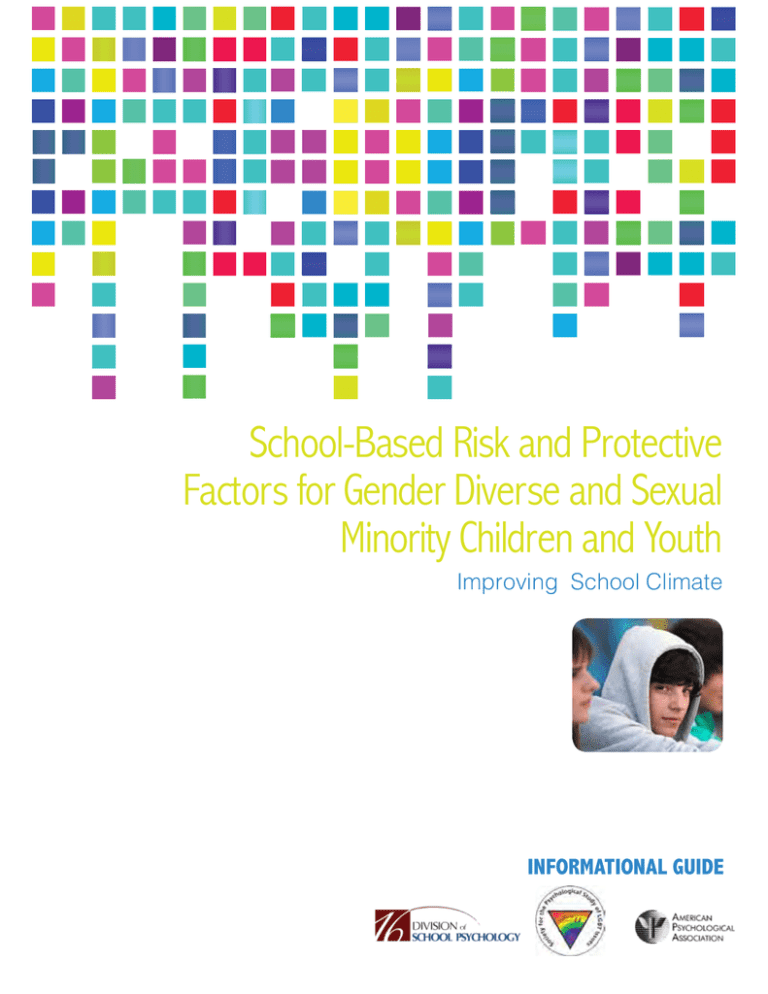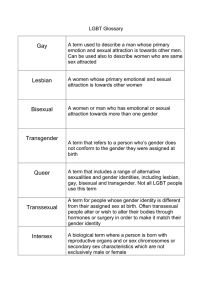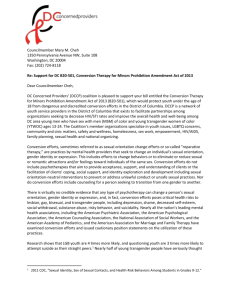
School-Based Risk and Protective
Factors for Gender Diverse and Sexual
Minority Children and Youth
Improving School Climate
INFORMATIONAL GUIDE
About this Series
This resource is part of a series of informational guides from Division 16 (School Psychology) and Division 44 (Society for
the Psychological Study of Lesbian, Gay, Bisexual and Transgender Issues) of the American Psychological Association.
This series, “Promoting Resiliency for Gender Diverse and Sexual Minority Students in Schools,” sets out best practices
for educators, school counselors, administrators and personnel, based on the latest research on the needs of lesbian,
gay, bisexual, transgender, queer, gender diverse, questioning and intersex students. The series includes topics such
as gender diversity among students, helping to support families with LGBT children and youth, risk factors and resiliency
factors within schools around health and wellbeing of LGBT youth, and basic facts about gender diversity and sexual
orientation among children and youth.
SERIES INCLUDES:
Pamphlet 01
Pamphlet 04
Pamphlet 02
Pamphlet 05
How Educators Can Support Families With Gender
Diverse And Sexual Minority Children and Youth
School-Based Risk and Protective Factors for
Gender Diverse and Sexual Minority Children and
Youth: Improving School Climate
Supporting Transgender and Gender Diverse
Students in Schools: Key Recommendations for
School Health Personnel
Key Terms and Concepts in Understanding Gender
Diversity and Sexual Orientation among Students
Pamphlet 03
Supporting Transgender and Gender Diverse
Students in Schools: Key Recommendations for
School Administrators
Sobering Statistics
A national survey (Kosciw, Greytak, Bartkiewicz, Boesen, & Palmer, 2012) finds that gender diverse and sexual
minority youth:
71%
Hear peers make negative
remarks about sexual
orientation (71%) and
gender expression (61%)
57%
Hear teachers make negative
remarks about sexual
orientation (57%) and
gender expression (57%)
82%
Are verbally harassed
because of sexual
orientation (82%) or
gender expression (64%)
38%
Are physically harassed
because of sexual
orientation (38%) or
gender expression (27%)
64% of students feel unsafe at school because of sexual orientation prejudice, and 44% feel unsafe at school because
of gender expression. When gender diverse and sexual minority youth experienced harassment or assault, over 60%
did not report the incident to school staff, often because they believed that little action would be taken or that the
situation would be made worse by reporting (Kosciw, Greytak, Bartkiewicz, Boesen, & Palmer, 2012).
25
Purpose of the Resource
Lesbian, gay, bisexual, transgender,
questioning and intersex (LGBTQI)
students often experience a hostile
school climate due to harassment,
bullying, and victimization based
on their actual or perceived sexual
orientation and/or gender identity.
These factors may contribute to a
number of negative outcomes for
LGBTQI youth at school, including
missing school, lower academic
achievement, increased isolation,
lowered self-esteem, substance use/
abuse, and increased suicidality. As
educators consider school climate for
LGBTQI youth, it is critical that they
keep in mind that being LGBTQI does
not necessarily put youth at increased
risk for negative outcomes; rather,
being LGBTQI in hostile, unsafe, and
unsupported environments puts youth
at increased risk.
The school classroom has
been described to be “the most
homophobic of all social institutions”
(Mufioz-Plaza, Quinn, & Rounds,
2002, p. 53).
These experiences contribute to a
hostile school climate for LGBTQI.
Students who reported higher
levels of victimization at school,
also reported (Kosciw, Greytak,
Bartkiewicz, Boesen, & Palmer, 2012):
• Increased absenteeism
• Lower academic achievement
• Fewer plans for post-secondary
education
• Poorer psychological well-being
(i.e., higher levels of depression and
lower self-esteem)
A growing body of research (e.g.,
Ameida, Johnson, Corliss, Molner, &
Azrael, 2009; D’Augelli, 2003; SavinWilliams & Ream, 2003) has found
various detrimental psychological
outcomes of recurring bullying
and victimization based on one’s
sexual orientation and/or gender
identity, such as, higher instances of
depression, suicides, and suicidal
ideation among LGBTQI youth in
comparison to their heterosexual
peers.
School-Based Protective Factors for LGBTQI
Federal and State policies (i.e., The Student
Nondiscrimination Act) can provide a solid foundation
for school interventions (Heck, Flentje, & Cochran,
2011) by:
Educators can help create a safe school climate for
LGBTQI youth by (Kosciw, Greytak, Bartkiewicz, Boesen,
& Palmer, 2012):
• Creating, implementing, and enforcing a comprehensive
bullying/harassment policy that specifically addresses
bullying based on sexual orientation and gender identity/
expression.
• Supporting a Gay-Straight Alliance or similar club
• Developing inclusive curriculum that includes positive
images of LGBTQI individuals, history, and events.
• Identifying themselves as supporters and allies of
LGBTQI youth
• Prohibiting discrimination based on sexual orientation
and/or gender identity within public schools and
providing efficient legal solutions (i.e. legal action and/
or loss of federal funding) if schools do not include
sexual orientation and gender identity in their nondiscrimination policy
• Allowing for inclusive curriculum that affords LGBTQI
youth a sense of futurity and sex education policies
that give voice to LGBTQI students’ experiences and
challenge structures of heteronormativity (Mayo, 2006)
• Allowing students to form Gay-Straight Alliances,
and having equal access to hold meetings on school
property, and preventing them from being monitored
any differently than other school organizations/clubs
(Cahill & Cianciotto, 2004)
26
Other School & Community Factors Impacting
LGBTQI Youth
• LGBTQI youth living in the Southern and Midwestern United States report higher overall victimization and less access
to LGBT-related resources.
• LGBTQI youth in schools in rural areas and small towns report greater victimization at school and less access to LGBTrelated resources or supports at school.
• LGBTQI youth in middle schools report higher levels of harassment and fewer school-site support services than youth
in high schools.
REFERENCES
Almeida, J., Johnson, R. M., Corliss, H. L., Molnar, B. E., & Azrael, D. (2009). Emotional distress among LGBT youth: The influence of
perceived discrimination based on sexual orientation. Journal of Youth Adolescence, 38, 1001-1014.
Cahill, S., & Cianciotto, J. (2004). U.S. policy interventions that can make schools safer. Journal of Gay & Lesbian Issues in Education,
2, 3-17.
Heck, N. C., Flentje, A., & Cochran, B. N. (2011). Offsetting risks: high school gay-straight alliances and lesbian, gay, bisexual, and
transgender (LGBT) youth. School Psychology Quarterly, 26, 161-174.
D’Augelli, A. R. (2003). Mental health problems among lesbian, gay, and bisexual youths ages 14 to 21. Clinical Child Psychiatry and
Psychiatry, 7, 439-462.
Kosciw, J. G., Greytak, E. A., Bartkiewicz, M. J., Boesen, M. J., & Palmer, N. A. (2012). The 2011 National School Climate Survey: The
experiences of lesbian, gay, bisexual and transgender youth in our nation’s schools. New York: GLSEN.
Mayo, C. (2006). Pushing the limits of liberalism: Queerness, children, and the future. Educational Theory, 56, 469-487.
Mufioz-Plaza, C., Quinn, S. C., & Rounds, K. A. (2002). Lesbian, gay, bisexual, and transgender students: Perceived social support in
the high school environment. The High School Journal, 85, 52-63.
Savin-Williams, R. C., & Ream, G. L. (2003). Suicide attempts among sexual minority male youth. Journal of Clinical Child and
Adolescent Psychology, 32, 509-522.
27
A publication of the American
Psychological Association,
Divisions 16 and 44 © 2015









